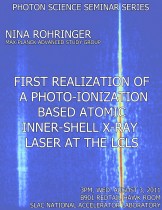Speaker: Nina Rohringer, Theoretical physicist Max-Planck Advanced Study Group
Nina Rohringer is a theoretical physicist with focus on Atomic, Molecular and Optical (AMO) physics at the Max-Planck Advanced Study Group at the Center for Free-Electron Science at DESY in Hamburg, Germany. She has received her PhD from Vienna University of Technology, Austria (Technische Universität Wien) in 2005, with a dissertation on fundamental aspects of Time Dependent Density Functional Theory. During her postdoctoral appointment at Argonne National Laboratory, Nina switched to the field of x-ray AMO science. Her theoretical work on the interaction of high-intensity x-ray free-electron laser radiation with atoms helped to guide and interpret the first user experiments at the LCLS short wavelength x-ray free-electron laser. In 2007 she joined Lawrence Livermore National Laboratory, where she started a theoretical and experimental effort to study the interaction of x-ray free-electron lasers with dense atomic gases.
Program Description
The availability of x-ray free-electron lasers enables the study of quantum optical effects in the x-ray regime. The most prominent example of quantum optics is probably the atomic laser. Since the invention of the laser fifty years ago, laser amplification of atomic transitions have been extended to increasingly high power and shorter wavelength. The photo-ionization based inner‐shell x‐ray lasing scheme was first proposed in 1967 (M. A. Duguay and G. P. Rentzepis), but due to the requirement of an extremely fast and intense x‐ray pump, could never be realized so far. We report on the first successful demonstration of this lasing scheme at the Linac Coherent Light Source. By focusing LCLS x‐ray pulses into a neon gas sample, a long narrow plasma column is produced on femtosecond time scale, by photoionization of a K‐shell electron. Thereby, a population inversion of the 2p‐1s transition (850 eV) in singly ionized neon is established, lasting for only a few femtoseconds due to the subsequent Auger decay of the created core hole. Fluorescence photons, emitted at the front‐end of the plasma column, get amplified by stimulated emission, resulting in ultra bright, femtosecond x‐ray pulses at 850 eV photon energy at the exit of the plasma column.





